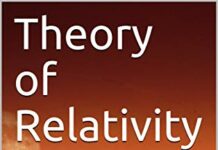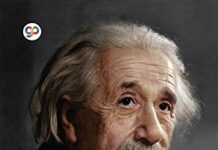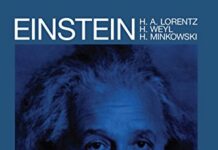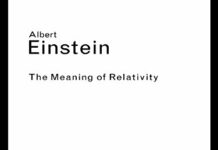
Ebook Info
- Published: 2021
- Number of pages: 198 pages
- Format: PDF
- File Size: 2.14 MB
- Authors: Albert Einstein
Description
Five extraordinary papers by Albert Einstein that transformed physics, edited and introduced by John Stachel and with a foreword by Nobel laureate Roger Penrose After 1905, Einstein’s miraculous year, physics would never be the same again. In those twelve months, Einstein shattered many cherished scientific beliefs with five extraordinary papers that would establish him as the world’s leading physicist. This book brings those papers together in an accessible format. The best-known papers are the two that founded special relativity: On the Electrodynamics of Moving Bodies and Does the Inertia of a Body Depend on Its Energy Content? In the former, Einstein showed that absolute time had to be replaced by a new absolute: the speed of light. In the second, he asserted the equivalence of mass and energy, which would lead to the famous formula E = mc2.The book also includes On a Heuristic Point of View Concerning the Production and Transformation of Light, in which Einstein challenged the wave theory of light, suggesting that light could also be regarded as a collection of particles. This helped to open the door to a whole new world—that of quantum physics. For ideas in this paper, he won the Nobel Prize in 1921.The fourth paper also led to a Nobel Prize, although for another scientist, Jean Perrin. On the Movement of Small Particles Suspended in Stationary Liquids Required by the Molecular-Kinetic Theory of Heat concerns the Brownian motion of such particles. With profound insight, Einstein blended ideas from kinetic theory and classical hydrodynamics to derive an equation for the mean free path of such particles as a function of the time, which Perrin confirmed experimentally. The fifth paper, A New Determination of Molecular Dimensions, was Einstein’s doctoral dissertation, and remains among his most cited articles. It shows how to calculate Avogadro’s number and the size of molecules.These papers, presented in a modern English translation, are essential reading for any physicist, mathematician, or astrophysicist. Far more than just a collection of scientific articles, this book presents work that is among the high points of human achievement and marks a watershed in the history of science.Coinciding with the 100th anniversary of the miraculous year, this new paperback edition includes an introduction by John Stachel, which focuses on the personal aspects of Einstein’s youth that facilitated and led up to the miraculous year.
User’s Reviews
Reviews from Amazon users which were colected at the time this book was published on the website:
⭐I purchased this book so that I could read Einstein’s 1905 papers (in English translations). The book gives you these (actually instead of the paper written from his thesis, the book provides the thesis itself), and much more. The book starts with a short, interesting, forward by Roger Penrose, which puts these papers in the context of previous and contemporaneous physics. There is then a lengthy (70 page) new introduction to this centenary edition of the book. This introduction provides interesting historical information about Einstein’s life and the development of these 1905 papers, particularly with regard to the charge (clearly refuted in this introduction) that Einstein’s wife Mileva was an unsigned co-author of these 1905 papers (or the perhaps the real author). Then there is the original 25-page introduction that provides more information regarding the development of these 1905 papers. Following this are the papers themselves, each of which is preceded by a technical discussion of the paper. Finally, there are editor’s notes following each paper that correct mistakes and help explain a few points.The material that is provided in addition to the papers actually occupies more pages than the papers themselves and is definitely a very welcome addition. In fact, I think that they are a primary reason to get his book. Einstein’s papers, while generally quite short are not the easiest to follow (at least I found this to be the case), so the notes preceding and following each paper defiantly helped me understand the papers and the context in which they were written. This is happily a case where I got much more than I had expected.I highly recommend this book to those interested in Einstein, the history of science and the development of his physics. A reader will find some prior understanding of physics to be very helpful, but there is enough general historical material to make the book interesting to those without such a background.
⭐What a pleasure to read the original papers on Special Relatvity with eactly the content provided by Einstein. In our physics classes we we studied this original material in conjunction with later material added by Lorentz and Minkowski.. The original material is fascinating in its simplicity. The rest of the book is other work done by Einstein in 1905, incuding hs dissertation onthe size of molecules, Brownian Motion, and the quantum hypothesis. We find out things we have never heard in John Stachel’s interesting introductions to the papers. For example, the only comment that his thesis advisor had on Einstein’s dissertation was that it was too short. Einstein then added a single sentence and the paper was accepted. If any grad student ever deserved a PhD, he must surely be Einstein. This book is an invaluable reference to anyone studying the history of modern physics.
⭐As an undergraduate sociology major, I often wonder why I have spent decades trying to understand Einstein. No matter. Of everything I have read, this book is the best. The reason is that it gave me the first opportunity to read and ponder, albeit in translation, what Einstein actually wrote in 1905 that turned out to be a hinge that changed forever the direction of our understanding of reality. What could be more satisfying? Even if I still do not understand it….
⭐Advertised as 272 pages, got only 198. It looks like one of those books that were printed by Amazon. Not satisfied…
⭐As a retired physicist I have taken great interest in the history of science, especially the times around the turn of the twentieth century when so many new ideas were put forward which have the basis of quantum mechanics and our current thinking from cosmology to quarks. This little volume is recommended either for bedtime reading or more serious study. The personal history reveals aspects previously unknown to me and the five papers themselves, in their original form, demonstrate Einstein’s wonderful insightfulness and ability to make use of every aspect of a problem. Tney are a bit heavy going in themselves, and the mathematics is not for everyone, but what else would one expect from a distillation of so much into so relatively few words. I recommend this book to both the scintist and the layman who seeks a better understanding of these momentous mental leaps.
⭐Book as described in ad and arrived within estimated time.
⭐Excellent book on Einstein and his publications in 1905. It is a marvelous addition to the history of Physics
⭐I set myself the task of working thru his special relativity work (#3) in detail. A clear and lucid mind laying out his ideas both systematically and subtly.I think the only real way to understand einstein is to read him.
⭐Wie Roger Penrose in seinem Vorwort betont, bescherte der Beginn des 20. Jahrhunderts den Physikern gleich zwei Revolutionen: die Relativitätstheorie und die Quantenmechanik, beide sind mit einem Namen eng verbunden: Albert Einstein.Die Geschichte dieser Theorie, wie auch die Geschichte Albert Einsteins sind wahrhaft spektakulär. Im Jahr 1905 veröffentlichte Einstein fünf Arbeit auf verschiedenen Gebieten der Theoretischen Physik, jede beeinflusste die weitere Entwicklung dieser Bereiche wesentlich; für die Erklärung des photoelektrischen Effekts erhielt er 1921 den Nobelpreis. Historiker ziehen deswegen gern Parallelen zu Isaac Newtons Wunderjahr (annus mirabilis) 1666; in jenem Jahr schuf Newton, der vor der Pest aus Cambridge aufs Land geflohen war,die Grundlagen der Fluxionen Theorie und der Mechanik, der Farbenlehre und Gravitationstheorie.Auch Einstein arbeitete in einer Art geistigem Exil, nachdem er 1900 das Züricher Polytechnikum abgeschlossen hatte, fand er zunächst keine Anstellung an einer Universität, 1902 erhielt er, auf Empfehlung von Marcel Großmann eine Stelle am Berner Patentamt als Experte 3. Klasse, das ließ ihm genug Zeit für seine Leidenschaft, der Physik; bis 1905 hatte er bereits fünf Veröffentlichung in den Annalen der Physik fertiggestellt, die beachtlich aber nicht außergewöhnlich waren; so dass Einstein bis dahin als Wissenschaftler ein unbeschriebenes Blatt blieb.Hatte er sich schon während seines Studiums mit aktuellen wissenschaftlichen Problemen beschäftigt, so erlebte er 1905 eine wahre Explosion an wissenschaftlichen Gespür und Schaffenskraft, — wie Newton vor ihm — behandelte er eine Reihe von Problemen an der vordersten Front der damaligen Theoretischen Physik. Die Arbeiten umfassen eine Dissertation zur Bestimmung der Moleküldimensionen, die statistischen Erklärung der Brownschen Bewegung, die Begründung der Speziellen Relativitätstheorie, die Erklärung der Quantennatur des Licht, und nicht zuletzt die Materie Energie Äquivalenz, die in der legendären Formel E = mc^2 eine Konsequenz der Speziellen Relativitätstheorie zusammenfasst.Das vorliegende Bändchen präsentiert Wiederabdrucke dieser fünf Arbeiten Einsteins (in englischer Übersetzung) mit einer Einleitung von John Stachel, einem der renommiertesten Wissenschafts- Historikern, der sich u.a. ausführlich mit der “Genesis of General Relativity” beschäftigt hat; er kommentiert auch jeden Artikel und würdigt seine historische Bedeutung. Abgerundet wird die kleine Sammlung durch ein Vorwort von Roger Penrose.In üblichen Kursdarstellung der Theoretischen Physik wird in der Regel ein deduktiver Stil gepflegt, der Theorien in effektiver, oft axiomatischer, Art und Weise abhandelt; das ist sehr berechtigt, und in ihrer fertigen, geschliffenen und abgeschlossen Form, sind diese Theorien auch wunderbar elegant: etwa die relativistische Dynamik in vierdimensionaler Form. Wer aber den Grundlagen dieser heutigen Darstellung genauer nachspüren will, kommt nicht umhin, sich mit ihren Quellen zu beschäftigen; und das kann durch nichts besser geschehen, als durch das Studium wichtiger Originalarbeiten. Hier hat der Leser die Möglichkeit, das erste ‘Aufblitzen’ einer neuen Idee, oder Sichtweise, selbst zu verfolgen, oft noch ‘unverstellt’ von weiterem theoretischen Kalkül oder Apparat. Das trifft in besonderem Maße auf Einsteins “Zur Elektrodynamik bewegter Körper” zu, dessen kinematischer Teil zumindest, ist sogar für Anfänger mit bescheidenen mathematischen Kenntnissen verständlich.Insbesondere die beiden Schriften zur SRT und zur Licht- Quantelung, sind frühe Ausgangspunkte der beiden oben erwähnten Revolutionen in der Theoretischen Physik. In dem die vorliegende Edition, diese bedeutenden Originalquellen einem breiteren Publikum zugänglich macht, ist sei sicherlich ein schöner Beitrag zum 100. Jubiläum von Einsteins Wunderjahr.NB: das Buch erschien auch in deutscher Übersetzung „Einsteins annus mirabilis“ als rororo Taschenbuch.
⭐Se plonger dans les textes originaux d’Einstein, c’est instructif. Réservé cependant aux connaisseurs, car le langage de la physique a évolué en un siècle
⭐
Keywords
Free Download Einstein’s Miraculous Year: Five Papers That Changed the Face of Physics in PDF format
Einstein’s Miraculous Year: Five Papers That Changed the Face of Physics PDF Free Download
Download Einstein’s Miraculous Year: Five Papers That Changed the Face of Physics 2021 PDF Free
Einstein’s Miraculous Year: Five Papers That Changed the Face of Physics 2021 PDF Free Download
Download Einstein’s Miraculous Year: Five Papers That Changed the Face of Physics PDF
Free Download Ebook Einstein’s Miraculous Year: Five Papers That Changed the Face of Physics





